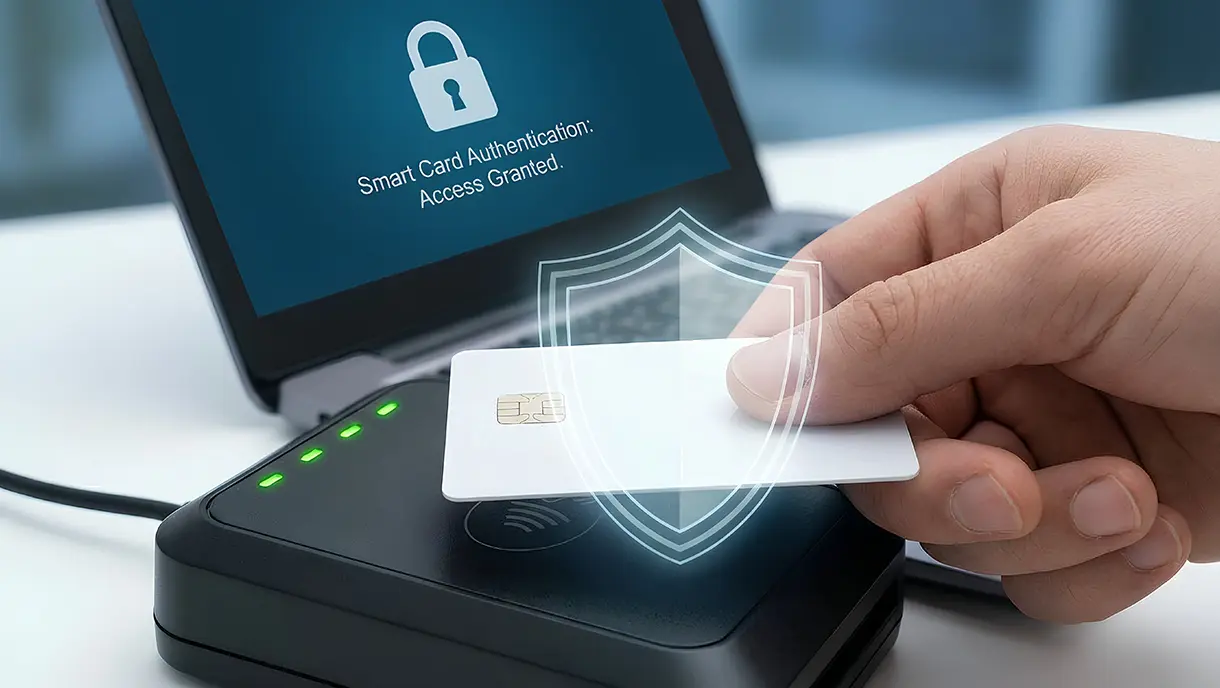Passwordless Authentication for Zero-Trust: Modern Security Without Compromise
Passwordless authentication is transforming enterprise security by eliminating passwords, reducing vulnerabilities, and enhancing user experience. This blog explores methods, implementation steps, and key considerations for adopting passwordless authentication while supporting Zero-Trust principles. OLOID’s platform offers a secure, scalable solution to help organizations modernize access management effectively.

Tired of dealing with password resets, phishing attempts, and constant login frustrations while still worrying about security gaps? You’re not alone. For IT leaders and security teams, passwords remain one of the most significant vulnerabilities. They are easy for attackers to exploit and frustrating for employees to manage.
That’s why more organizations are shifting toward Zero-Trust security, where every access request must be verified based on identity, context, and device posture. But here’s the problem: even inside a zero-trust framework, passwords create a weak point that can be exploited, undoing all the effort you’ve put into strengthening your defenses.
This is where passwordless authentication changes the game. By replacing passwords with stronger, seamless methods like biometrics, security keys, or mobile authenticators, organizations can close that gap. The result? Better security, smoother user experience, and fewer headaches for IT teams.
In this blog, we’ll explore how passwordless authentication fits into a zero-trust strategy, the key benefits it delivers, the challenges to watch out for, and practical steps to start your journey. If you’re looking for a way to strengthen security while simplifying access, this guide is for you.
What Is Passwordless Authentication?
Passwordless authentication is a method of verifying a user’s identity without the use of traditional passwords. Instead of relying on knowledge-based credentials, it uses secure alternatives such as biometrics, cryptographic keys, or registered devices to confirm identity.
This approach involves using a passwordless authentication platform that removes the need for users to create, remember, or manage passwords. Additionally, passwordless authentication eliminates the vulnerabilities associated with passwords, such as phishing, brute-force attacks, and credential reuse.
By binding authentication to factors that are unique and more difficult to compromise, passwordless authentication offers both stronger security and improved usability.
Types of Passwordless Authentication Methods
- Biometrics: Facial recognition, fingerprint scans, iris scans, or voice identification, which are unique to each individual and cannot be easily duplicated.
- Hardware Tokens: Dedicated physical devices such as FIDO2 security keys that generate or store cryptographic credentials.
- FIDO2/WebAuthn Standards: Industry-standard protocols that enable browsers and devices to support password-free logins using public-key cryptography.
- Mobile Push Notifications: Authentication requests are sent to a registered mobile device, where users approve access with a single tap instead of entering a password.
By eliminating reliance on static credentials and using cryptographic methods, passwordless authentication provides stronger, phishing-resistant access controls.
This foundational shift makes it a natural enabler of modern security frameworks; most notably, Zero-Trust, where continuous verification and least-privilege access are paramount.
Zero-Trust and Passwordless: A Perfect Match
Zero-Trust security operates on the principle that trust must be continuously verified. As per a Gartner report, 63% of organizations have implemented the Zero-Trust strategy.
Passwordless authentication aligns seamlessly with this model by enabling secure, user-centric access without relying on vulnerable credentials.
1. Alignment With Zero-Trust Principles
Zero-Trust requires verification of every user, device, and access request; no implicit trust is granted based on network location or past behavior. Passwordless authentication supports this by relying on strong identity signals such as biometrics, hardware tokens, and cryptographic keys.
These methods ensure that authentication is tied to the individual and their device, delivering real-time validation consistent with Zero-Trust requirements.
2. Eliminates Password Vulnerabilities
Passwords remain the single most exploited attack surface in enterprise security, vulnerable to phishing, credential stuffing, and reuse. Within a Zero-Trust framework, relying on passwords undermines the model’s effectiveness by leaving a critical weak point exposed.
Passwordless authentication removes this risk entirely by eliminating static credentials and replacing them with secure, phishing-resistant methods that strengthen the overall Zero-Trust posture.
3. Enables Adaptive and Contextual Access
Zero-Trust emphasizes granting the right level of access based on real-time risk signals. Passwordless solutions enhance this by incorporating adaptive mechanisms such as behavioral analysis, device posture checks, and geolocation data.
For example, a login attempt from an unrecognized device in a high-risk region may trigger step-up authentication, while a trusted device in a normal context enables seamless access. This contextual intelligence ensures that Zero-Trust policies remain both secure and user-friendly.
With a clear understanding of how passwordless authentication complements Zero-Trust principles, the next step is to explore practical strategies for implementing these solutions effectively across your organization while maintaining security, compliance, and user convenience.
[[cta]]
How to Implement Passwordless Authentication in a Zero-Trust Framework
Implementing passwordless authentication within a Zero-Trust framework requires careful planning, the right technology, and ongoing management. The following steps provide a structured approach for organizations seeking to modernize their access strategy while maintaining security and usability.
Step 1: Assess Current Identity & Access Management (IAM)
Before introducing passwordless authentication, it’s essential to evaluate your existing Identity and Access Management (IAM) infrastructure. This step ensures that you understand current workflows, potential vulnerabilities, and how new authentication methods will integrate with your systems.
Actions to Take
- Review current IAM systems, authentication workflows, and policies.
- Map user roles, permissions, and critical applications.
- Identify gaps or integration challenges for passwordless deployment.
Step 2: Choose the Right Passwordless Technology
Selecting the right authentication method is critical for both security and usability. When evaluating different passwordless authentication methods, consider technologies that align with your organization’s devices, user base, and compliance requirements.
Actions to Take
- Evaluate options such as biometric authentication, FIDO2 security keys, and mobile push-based authentication.
- Assess device compatibility, scalability, and ease of use for employees.
- Ensure solutions meet regulatory and compliance standards.
Step 3: Integrate With Zero-Trust Architecture
Passwordless authentication should work seamlessly with your Zero-Trust framework. This integration ensures access decisions are context-aware and aligned with least-privilege principles.
Actions to Take
- Apply least-privilege access policies to all users.
- Implement conditional access based on device posture, location, and risk signals.
- Enable continuous monitoring to detect anomalies and enforce dynamic access controls.
Step 4: Educate Users and Stakeholders
Successful adoption depends on user readiness and understanding. Training and communication are key to minimizing friction and ensuring employees embrace passwordless methods.
Actions to Take
- Provide clear instructions and training on new authentication methods.
- Highlight security benefits and operational improvements.
- Use change management strategies to address resistance and promote consistent adoption.
Step 5: Monitor and Iterate
Deployment is just the beginning. Continuous monitoring and iterative improvements are crucial to maintaining security and keeping the system aligned with evolving threats and organizational needs.
Actions to Take
- Regularly audit authentication events and access logs.
- Analyze user behavior and device activity to identify anomalies.
- Update policies, procedures, and technologies based on insights and changing requirements.
While these implementation steps provide a clear roadmap, organizations must also be aware of potential challenges and considerations to ensure a smooth, secure deployment of passwordless authentication within a Zero-Trust framework.
[[cta-2]]
Considerations for Deploying Passwordless in Zero-Trust Frameworks
While passwordless authentication offers significant security and usability benefits, decision-makers must consider potential challenges to ensure a successful deployment. Addressing these considerations proactively helps organizations avoid disruptions, maintain compliance, and maximize the effectiveness of their Zero-Trust strategy.
1. Deployment Complexity
Problem Statement
Integrating passwordless authentication with existing legacy systems, cloud applications, and enterprise directories can be complex. Organizations often face challenges in ensuring seamless interoperability across diverse environments.
How To Overcome This
- Conduct a thorough assessment of existing systems and applications before deployment.
- Select passwordless solutions that support hybrid environments and standard protocols like FIDO2/WebAuthn.
- Pilot the implementation in controlled environments to identify and resolve integration issues early.
2. Device and Platform Compatibility
Problem Statement
Passwordless authentication methods rely on hardware and software capabilities that may vary across devices and platforms. Limited support can create gaps in coverage, reducing security and user adoption.
How To Overcome This
- Inventory all endpoint devices and assess compatibility with chosen authentication methods.
- Choose solutions that offer cross-platform support for desktops, laptops, mobile devices, and web applications.
- Ensure fallback mechanisms are available for unsupported devices to maintain uninterrupted access.
3. User Adoption & Accessibility
Problem Statement
Introducing new authentication methods can cause friction, especially for employees unfamiliar with biometrics or security keys. Poor adoption can undermine both security and productivity.
How To Overcome This
- Provide comprehensive training and clear guidance on using passwordless methods.
- Communicate the benefits of passwordless authentication, such as faster logins and reduced password fatigue.
- Offer multiple authentication options to accommodate different user needs and accessibility requirements.
4. Regulatory & Compliance Requirements
Problem Statement
Organizations must comply with industry regulations such as HIPAA, GDPR, and PCI DSS. Passwordless deployments that do not meet regulatory standards can lead to legal and financial risks.
How To Overcome This
- Choose passwordless solutions that are compliant with relevant regulations and industry standards.
- Implement policies for secure storage and transmission of authentication data.
- Conduct regular audits and assessments to ensure ongoing compliance and adjust processes as needed.
With these considerations in mind, organizations can not only implement passwordless authentication effectively today but also prepare for the evolving innovations and trends shaping the future of Zero-Trust security.
The Future of Passwordless Authentication and Zero-Trust
As organizations continue to prioritize security and user experience, the role of passwordless authentication within Zero-Trust frameworks is evolving rapidly. Emerging technologies and innovative approaches are transforming how enterprises secure access while minimizing friction for users.
1. AI-Driven and Behavioral Authentication
Artificial intelligence and machine learning are increasingly being used to enable continuous verification of user identities. By analyzing patterns such as login behavior, device usage, and typical activity, AI can detect anomalies in real time and trigger step-up authentication only when necessary.
This approach strengthens security while reducing unnecessary interruptions for legitimate users.
2. Invisible and Contextual Authentication
The future of authentication is moving toward seamless, background verification. Contextual authentication methods evaluate risk factors such as geolocation, device posture, and network conditions to grant or restrict access automatically.
Users benefit from a smoother experience, gaining access without repeated logins, while security teams maintain confidence in the integrity of every access request.
3. Expanding Zero-Trust Adoption
Zero-Trust is no longer a niche strategy; it is becoming an enterprise-wide standard across industries. As more organizations adopt this model, passwordless authentication will play a central role in implementing secure, scalable, and user-friendly access controls.
Future deployments will increasingly combine adaptive authentication, cloud-native security, and AI-driven insights to meet evolving threats and regulatory requirements.
[[cta-3]]
Augment Zero-Trust Security with Passwordless Authentication
As organizations continue to adopt Zero-Trust security, passwordless authentication is emerging as a key enabler of stronger, more seamless access. By eliminating passwords, enterprises reduce attack surfaces, strengthen identity verification, and deliver employees a faster, frictionless login experience.
Beyond enhanced security, passwordless solutions simplify access management and support compliance across devices, applications, and regulatory frameworks. When implemented strategically, they empower IT and security teams to achieve Zero-Trust goals without introducing complexity or user frustration.
Why OLOID
OLOID’s enterprise-grade passwordless authentication platform is purpose-built for modern Zero-Trust environments. It combines security, scalability, and usability through key capabilities such as:
- Multi-Device Support: Secure authentication across desktops, laptops, mobile devices, and web applications.
- Seamless Integration: Compatibility with existing IAM systems, cloud apps, and legacy infrastructure for easy deployment.
- Zero-Trust Alignment: Enforces least-privilege access, continuous verification, and adaptive, context-aware authentication.
- Regulatory Compliance: Designed to meet HIPAA, GDPR, PCI DSS, and other compliance standards with robust security controls.
OLOID enables organizations to strengthen Zero-Trust security while improving user experience and operational efficiency, ensuring that access remains both secure and effortless.
Accelerate Your Zero-Trust Journey
Passwordless authentication is no longer optional - it’s a foundational step toward a secure, adaptive enterprise.
Discover how OLOID can help you eliminate passwords, simplify identity management, and achieve Zero-Trust without compromise.
Book a personalized demo to see how OLOID’s passwordless authentication platform can transform your enterprise security today.
Frequently Asked Questions
1. How does passwordless authentication enhance zero-trust security?
Passwordless authentication removes the reliance on static credentials, which are often the weakest link in enterprise security. By leveraging secure, user-bound factors like biometrics, hardware security keys, or mobile authenticators, it ensures that every access request is verified based on strong identity signals.
This aligns perfectly with Zero-Trust principles, supporting continuous verification, least-privilege access, and adaptive, context-aware authentication.
2. What are the common types of passwordless authentication methods?
Common passwordless methods include:
- Biometrics: Fingerprint scans, facial recognition, or voice authentication unique to each user.
- Hardware Security Keys: FIDO2-compliant devices that store cryptographic credentials.
- Mobile Push Authentication: One-tap approval via a registered mobile device.
- Certificate-Based or Token-Based Authentication: Public-key cryptography replaces passwords for secure access.
These methods reduce vulnerabilities while providing a seamless login experience for users.
3. Is passwordless authentication compliant with security regulations?
Yes. Modern passwordless solutions are designed to meet industry and regulatory standards such as HIPAA, GDPR, PCI DSS, and other compliance frameworks. By securely storing and transmitting authentication data, enforcing encryption, and enabling audit trails, organizations can maintain regulatory compliance while strengthening security.
4. Can passwordless authentication work with legacy applications and systems?
Passwordless authentication can be integrated with many legacy and hybrid environments, though it may require additional configuration or middleware. Solutions that support standard protocols like FIDO2/WebAuthn and offer flexible integration options can work alongside both cloud-based applications and on-premises systems, ensuring broad enterprise coverage without disrupting existing workflows.
5. How can organizations get started with passwordless authentication in a zero-trust framework?
To implement passwordless authentication effectively:
- Assess existing IAM systems and access policies to identify gaps and integration points.
- Choose the appropriate passwordless technologies based on device compatibility, scalability, and compliance needs.
- Integrate authentication into your Zero-Trust framework, including least-privilege access, conditional access, and continuous monitoring.
- Educate users and stakeholders to encourage adoption and reduce friction.
- Monitor and iterate through regular audits, behavioral analytics, and policy adjustments to maintain security and usability.






Get the latest updates! Subscribe now!




